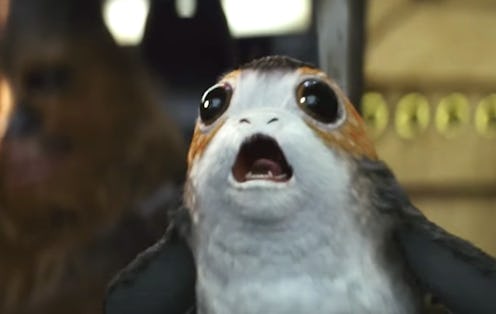Entertainment
This Amazing Fact About The Porgs In 'The Last Jedi' Will Make You Even More Obsessed

As much as there is to argue over in The Last Jedi, one element that's stayed on everyone's mind is porgs. And whether you love or hate them, you might think your attitude is fixed. But until you hear about where the Star Wars porgs came from, you shouldn't make your mind all the way up. As it turns out, the fluffy little alien species that inhabits Luke Skywalker's remote island of Ahch-To was created not to help sell more Star Wars merchandise going into the holidays. (Although that aspect probably didn't hurt.) Instead, the tiny space critters were dreamed up in order to protect an animal that lives much closer to home — the puffin.
Earth-dwelling fans of the movie thought they'd noticed a lot of similarities between the porg and the penguin. Many lovingly referred to the alien species as "space penguins," and they were closer to the truth than they knew. The Atlantic puffin is a squat little seabird with a brightly-colored beak that has its run of a lot of these smaller islands in the North Atlantic. And the ancient Irish island of Skellig Michael was no exception; the UNESCO World Heritage Site was teeming with the little birds, and producers had to come up with a method of dealing with them.
There were too many to shoo away, they were too expensive to remove from the footage one by one, and this is a protected landscape, so the crew was very limited in the ways they could interfere with the birds. So what did they do? They put them in costumes.
Franchise creature designer Jake Lunt Davies did an interview for the official Star Wars site entitled "How Porgs Were Hatched," and had this to say about the beloved little monsters.
"From what I gathered, Rian [Johnson] had gone to shoot this sequence on Skellig Michael, which is the real island location that stands in for Ahch-To, and that island is covered in puffins. It’s a wildlife preserve and everywhere you look there are hundreds of birds dotted around the landscape."
And it would be kind of noticeable if all the little dots in the background were Earth-based species, right? A not-so-subtle reminder that we're in Ireland in 2017 and not in the far reaches of the galaxy many years in the future. But the creative team didn't let an obstacle like a couple thousand puffins get them down:
"From what I gathered, Rian, in a positive spin on this, was looking at how can he work with this. You can’t remove them. You physically can’t get rid of them. And digitally removing them is an issue and a lot of work, so let’s just roll with it, play with it. And so I think he thought, 'Well, that’s great, let’s have our own indigenous species.'"
How. Perfect. Is. That. And now that they mention the puffins, and you get to see the two species next to each other, it's easy to see how one informed the other. It's noticeable in the tiny little wings in close to the body, in the big sad eyes, and in the bright orange feet. These are intergalactic siblings, and it makes fans' love for the island-hoppers even more meaningful.
You have to appreciate when the cost-saving route is also the ethical route, which also happens to be the route that gives us an adorable creature like the porg. It's a creative solution to the problem presented by the proliferation of puffins, and it adds another layer of fun to watching the movie.
Just as you watch Snoke and imagine Andy Serkis under that creepy exterior, doing his motion capture work, you can bring those same eyes to the porgs. As they flutter happily over the island, just know that inside each digital skin is a contented little puffin, being carefully protected and disguised so they can stay in the movie and break into Hollywood.